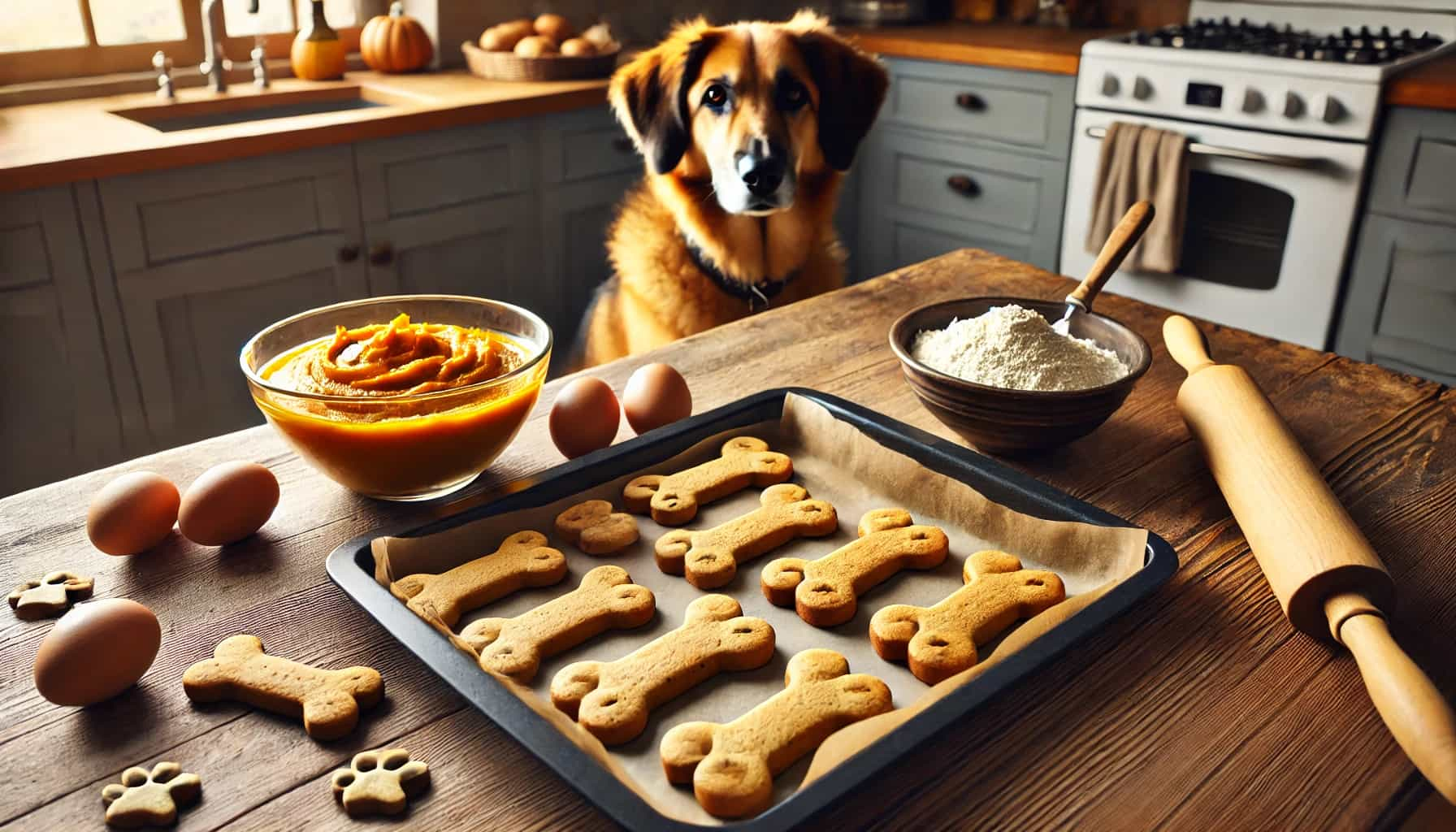Dog Biscuit with Pumpkin Recipe: A Healthy and Delicious Treat for Your Furry Friend
If you are searching for a wholesome and easy-to-make dog biscuit with pumpkin recipe, you are in the right place! Offering your pet homemade pumpkin dog treats can be both cost-effective and beneficial to your pup’s overall well-being. In this article, we will explore why pumpkin is a fantastic ingredient for dogs, how to make your own crunchy dog biscuits, and the various ways you can tailor the recipe to suit your pet’s taste buds.
Why Pumpkin is Great for Dogs
Pumpkin is not only a flavorful addition to dog treats, but it also comes packed with nutritional benefits. Dogs enjoy its subtle sweetness, and owners love the fact that pumpkin is easily digestible.
1. High in Fiber
Pumpkin is loaded with dietary fiber. For dogs experiencing digestive issues or irregularities, fiber can help regulate bowel movements. This can lead to fewer upset stomachs and a happier canine companion.
2. Essential Vitamins and Minerals
Pumpkin contains vitamins A, C, and E, along with potassium and iron. These nutrients help support a dog’s immune system, vision, and overall energy levels.
3. Low in Calories
If your dog is on the heavier side or if you want to maintain their healthy weight, pumpkin can be an excellent way to reduce calorie intake. Low-calorie dog biscuits with pumpkin are a delicious way to keep them satisfied without the excess calories.
Key Ingredients for Your Dog Biscuit with Pumpkin Recipe
Before you start baking, gather all your ingredients. Most of these items are readily available in your pantry or local grocery store. If they are not, a quick trip to a pet supply shop or organic market can help you find the best-quality, dog-friendly components.
- Canned Pumpkin (Unsweetened): Opt for pure pumpkin puree rather than pumpkin pie filling. The latter often contains sugar and spices that can be harmful to dogs.
- Whole Wheat Flour (or Oat Flour): Whole wheat flour is high in nutrients, but if your dog is sensitive to wheat, oat flour can serve as a more gentle alternative.
- Eggs: A binder that helps bring the dough together. Eggs also provide protein.
- Peanut Butter (Optional): Choose a peanut butter that does not contain xylitol, a sweetener that is toxic to dogs. Peanut butter adds a creamy texture and extra flavor.
- Water or Broth: Just enough liquid to form a workable dough. Low-sodium chicken or beef broth can boost flavor.
- Coconut Oil (Optional): Adding a small amount can help improve your dog’s skin and coat.
Below is a simple table summarizing the basic ingredients and their corresponding amounts:
| Ingredient | Quantity | Notes |
|---|---|---|
| Pumpkin Puree | 1 cup | Pure canned pumpkin (no added sweeteners) |
| Whole Wheat (or Oat) Flour | 2 cups | Use gluten-free flours if your dog has sensitivities |
| Egg(s) | 1 (large) | Adds protein and helps bind the dough |
| Peanut Butter | 2 tablespoons | Optional, ensure it’s xylitol-free |
| Water (or Broth) | ~ ¼ cup | Adjust based on dough texture, use low-sodium broth for flavor |
| Coconut Oil | 1 tablespoon | Optional, supports healthy coat and skin |
Step-by-Step Preparation
Creating your dog biscuit with pumpkin recipe is straightforward. By following these steps, you can produce consistently tasty and healthy treats every time.
1. Preheat and Prep
- Preheat your oven to 350°F (180°C).
- Line a baking sheet with parchment paper or use a silicone baking mat. This makes cleanup easier and prevents the biscuits from sticking.
2. Mix the Dry Ingredients
- In a large mixing bowl, combine the flour (whole wheat or oat) with any additional dry components, such as a pinch of ground flaxseed or dried parsley (optional).
3. Add the Wet Ingredients
- Stir in the pumpkin puree, egg, and peanut butter (if using).
- If the dough is too thick or crumbly, slowly add water or broth until you achieve a workable consistency.
4. Knead and Roll
- Knead the dough with your hands for a minute or two to ensure everything is thoroughly combined.
- Place the dough on a lightly floured surface and roll it out to about a ¼-inch thickness.
5. Cut Out the Biscuits
- Use cookie cutters or a pizza cutter to cut the dough into shapes or small squares that suit your dog’s size.
- Place the cutouts onto your lined baking sheet, spacing them out so the biscuits can bake evenly.
6. Bake to Perfection
- Bake for 20-30 minutes, or until the biscuits are golden brown. For extra-crunchy treats, you can leave them in the oven for an additional 5 minutes once you turn off the heat.
- Allow the biscuits to cool completely on a wire rack before offering them to your dog.
Variations and Flavor Enhancements
While the basic pumpkin dog biscuit recipe is delicious and nutritious on its own, you can explore several variations:
- Add Lean Protein: Incorporate finely shredded chicken or turkey for an extra protein boost.
- Make it Sweet: If your dog has a sweet tooth, add a small amount of mashed banana or unsweetened applesauce (but keep in mind moderation).
- Herbal Additions: Sprinkle in herbs like parsley or mint. Parsley can help freshen your dog’s breath, while mint adds a pleasant aroma.
- Switch Up the Flours: If your pet is gluten-sensitive, try buckwheat or coconut flour. Adjust the liquids accordingly to keep the dough workable.
- Cheesy Twist: A pinch of grated Parmesan or cheddar cheese can make the treats more savory. Just be mindful of extra salt content.
Storing Your Homemade Dog Biscuits
Proper storage can extend the freshness of your homemade dog treats. Here are some quick tips:
- Room Temperature: Store biscuits in an airtight container at room temperature for up to two weeks. Make sure they stay in a cool, dry area.
- Refrigeration: If you live in a warm or humid climate, consider storing biscuits in the fridge. This can keep them fresher for a longer period.
- Freezing: For bulk baking, freeze your dog biscuits in a zip-top bag or sealed container. They can last for up to three months in the freezer. Thaw only the amount you plan to use within a few days.
How to Serve Safely
To ensure your dog’s safety and enjoyment:
- Size Appropriately: Cut the biscuits into shapes and sizes suitable for your pet. Larger dogs may appreciate bigger biscuits, while smaller pups do better with bite-sized treats.
- Monitor First Time: If your dog has never had pumpkin or peanut butter, give them a small taste first to watch for any adverse reactions.
- Treats Are Not Meals: While these biscuits are healthier than many store-bought options, they should still be treated as occasional treats. Make sure to adjust your dog’s daily caloric intake accordingly.
Understanding Pumpkin and Dog Health
Many pet owners wonder if adding pumpkin to dog treats offers legitimate health benefits or if it is just another food trend. Studies suggest that in moderate amounts, pumpkin can aid digestion and offer a beneficial nutrient profile for canines. Still, it is essential to ensure your dog has no allergies to any of the recipe components and that you serve treats in moderation.
For more detailed guidance on dog nutrition, you can check out the
American Kennel Club’s guide to dog nutrition
This resource covers essential dietary information and helps pet owners make more informed decisions about what they feed their four-legged family members.
Related Keywords for Further Research
When diving into the world of homemade dog treats, it might help to explore additional topics and related keywords. This ensures you broaden your knowledge and discover new ways to improve your dog’s diet:
- Homemade Dog Treats
- Pumpkin Dog Treats
- Healthy Dog Biscuit Recipe
- DIY Dog Biscuits
- Baking Dog Treats at Home
- Dog Nutrition and Weight Management
Conclusion
Crafting a dog biscuit with pumpkin recipe at home has never been easier. Not only do homemade pumpkin dog treats offer a higher level of trust regarding ingredients, but they are also a cost-effective way to spoil your furry friend while promoting better digestion, healthy weight, and overall vitality.
By following the simple steps outlined in this article, you can personalize each batch to suit your dog’s palate and any specific dietary needs. From the selection of flours to adding peanut butter or lean proteins, the possibilities are endless. Most importantly, you can rest assured that each treat is made with love and wholesome ingredients tailored to your dog’s well-being.
Remember, treats should complement a balanced diet, never replace it. Always consult your veterinarian if you have concerns about specific dietary requirements or allergies. Armed with this knowledge, get ready to roll up your sleeves, fire up your oven, and share some tail-wagging goodness with your furry friend!




